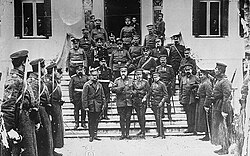
Back سباق التسلح البحري الأنجلو-ألماني Arabic Англа-германскі антаганізм Byelorussian Det engelsk-tyske flådekapløb Danish Deutsch-Britisches Flottenwettrüsten German رقابت تسلیحاتی نیروی دریایی انگلستان و آلمان Persian Course germano-britannique aux armements navals French Angol–német flottaépítési verseny Hungarian Perlombaan senjata laut Inggris-Jerman ID Corsa anglo-tedesca agli armamenti navali Italian 영국-독일 해군력 경쟁 Korean
| Events leading to World War I |
|---|
 |
|
The arms race between Great Britain and Germany that occurred from the last decade of the nineteenth century until the advent of World War I in 1914 was one of the intertwined causes of that conflict. While based in a bilateral relationship that had worsened over many decades, the arms race began with a plan by German Admiral Alfred von Tirpitz in 1897 to create a fleet in being to force Britain to make diplomatic concessions; Tirpitz did not expect the Imperial German Navy to defeat the Royal Navy.
With the support of the Kaiser Wilhelm II, Tirpitz began passing a series of laws to construct an increasing number of large surface warships. The construction of HMS Dreadnought in 1906 prompted Tirpitz to further increase the rate of naval construction. While some British observers were uneasy at German naval expansion, alarm was not general until Germany's naval bill of 1908. The British public and political opposition demanded that the Liberal government meet the German challenge, resulting in the funding of additional dreadnoughts in 1910 and escalating the arms race.
Maintaining Europe's largest army and second-largest navy took an enormous toll on Germany's finances. Theobald von Bethmann Hollweg, German chancellor from 1909, undertook a policy of détente with Britain to alleviate the fiscal strain and focus on the rivalry with France. Under Bethmann Hollweg, and particularly from 1912 onwards, Germany abandoned the dreadnought arms race and focused on a commerce raiding naval strategy to be conducted with submarines.
One of the ironies of the arms race and subsequent conflict was that, while the German battle fleet fought only one major surface engagement (the inconclusive Battle of Jutland) and never seriously threatened British naval supremacy, the commerce raiding strategy that had been the historic focus of German naval doctrine would consistently endanger British merchant shipping and imports throughout the war. The success of German submarine warfare during World War One had great influence on German Naval policy in the lead up to the Second World War, with the utilisation of both U-boats and fast, well armoured battlecruisers for commerce raiding being the primary task of the Kriegsmarine.